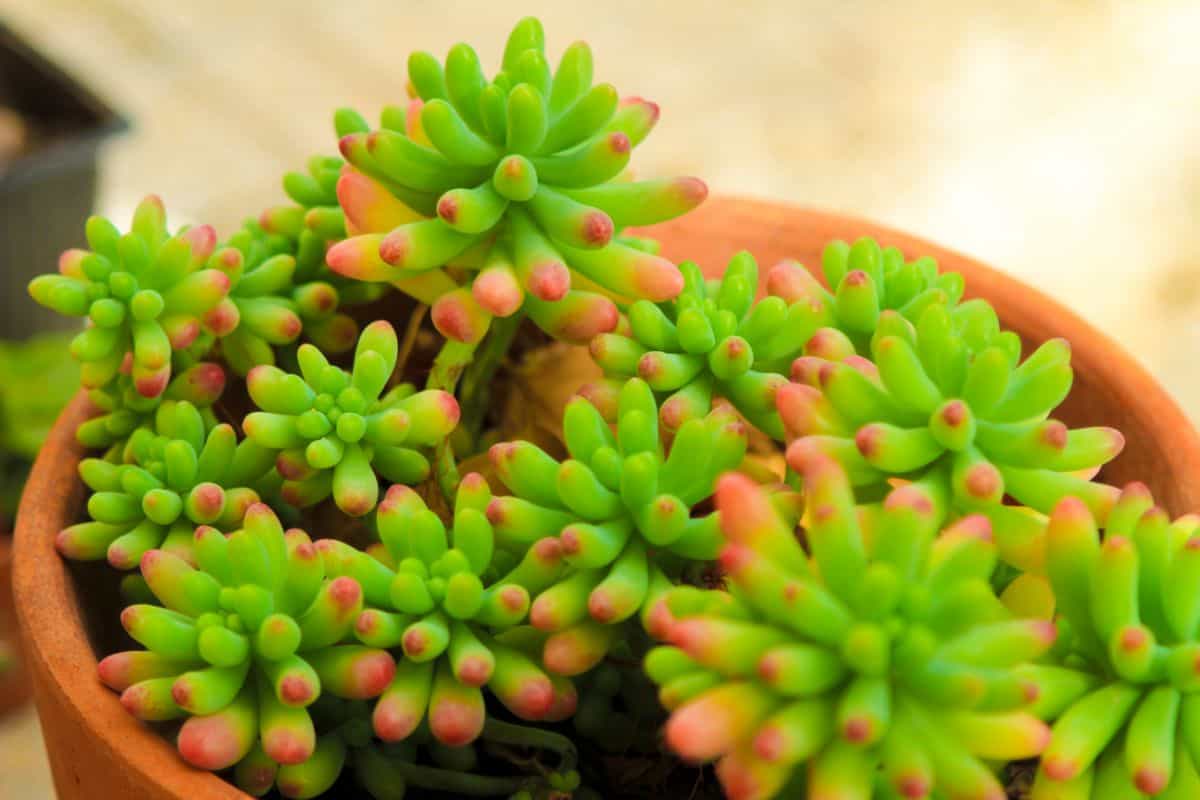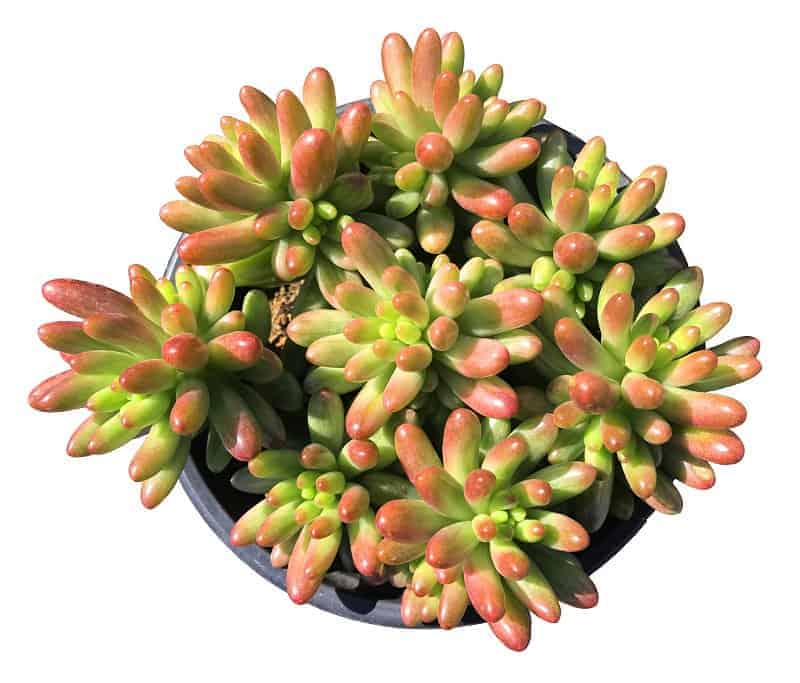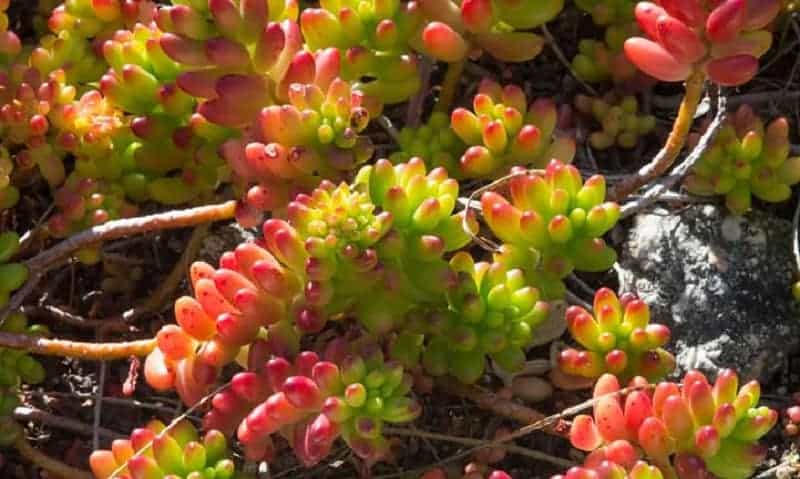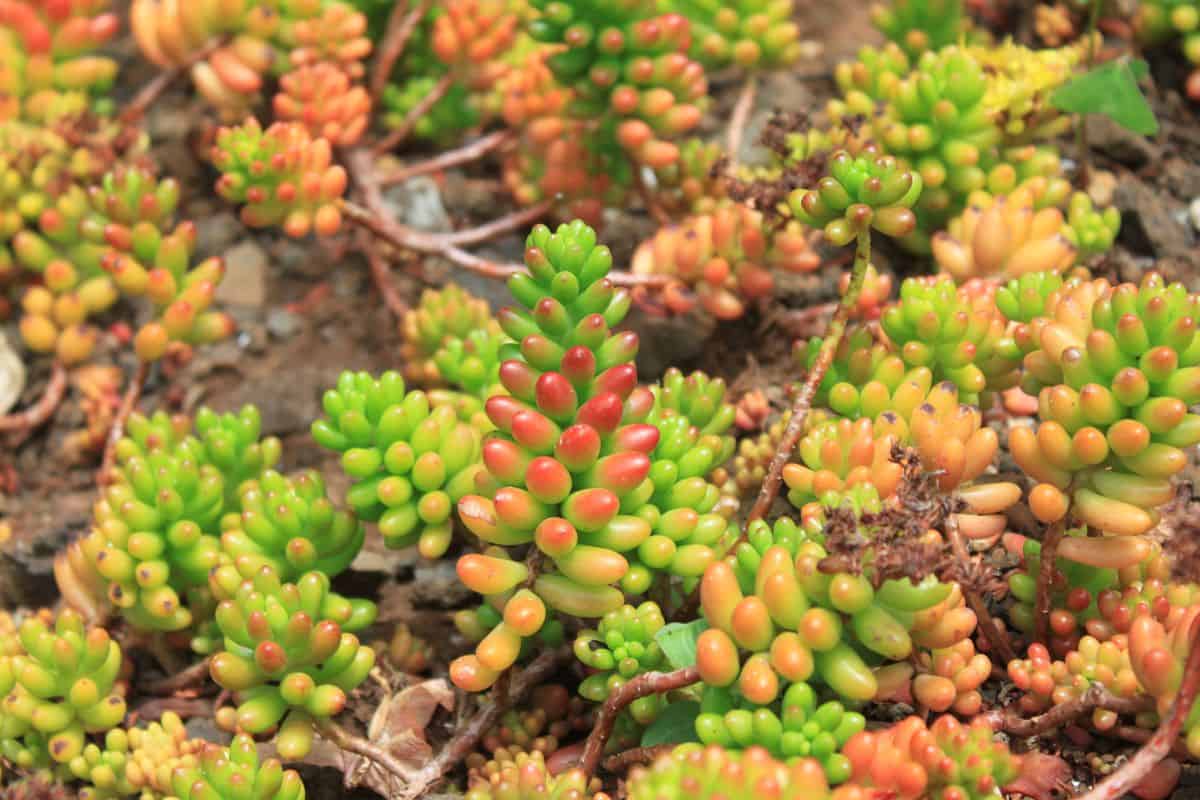Sedum rubrotinctum is a succulent type that grows little oval-shaped leaves that look like jelly beans, hence its nickname ‘jelly bean plant’. We are going to call it the jelly bean plant for the purpose of this article.

The jelly bean succulent is native to South Africa and the surrounding regions. It thrives when it is exposed to lots of sunlight and can even withstand drought and tough weather conditions. One thing this perennial succulent doesn’t like is frost, and its juicy leaves develop permanent scars when the plant is exposed to below freezing weather.
When its growing conditions are controlled, the jelly bean succulent can grow just about anywhere. You can plant it in your garden, have a few dotted around your greenhouse, or you can strategically place them around your home as part of the decor.
Succulents are easy to propagate, and the jelly bean plant is one of the easiest due to its ability to grow roots from any of its fallen leaves. If you are looking to create a small succulent gardening project and want to grow a few jelly bean succulents from one plant, you can do so without too much hassle. We have covered how to propagate your jelly bean succulent in this article, so stay tuned for instructions!
Jump to:
Jelly Bean Plant Features
| Name: | Sedum rubrotinctum |
| Soil: | Sandy soil |
| Blooming: | Mid-spring to summer |
| Light: | Full sun |
| Water: | When the soil is completely dry |
| Propagation: | Fallen leaves or cuttings. |
If you are a big succulent lover, you will know that sometimes it can be hard to identify the different types of succulents. It is no surprise when there are so many succulents that are calcified in over 60 families of plants. Here are some of the jelly bean plan’s common features that make it stand out above the rest:
Leaves

The jelly bean succulent has small bean-shaped leaves that are light green in color. You can expose your succulent to stressful conditions to make its leaves turn a soft red color at the tips. A happily stressed succulent is one that is exposed to a bit more sunlight and heat than is advised. You can also water it less frequently and add more nutrients to the soil to transition your plant to a happily stressed state. I advise you do this only when you are confident in your jelly bean succulent care.
Height
This succulent stays close to the ground. It can reach heights of 20 cm tall; after that, the plant will start to lean to the side. You can expect the leaves, or shall we call them the beans, to grow to about two centimeters long.
Growth Pattern
You will notice that the jelly bean plant’s leaves grow in a spiral around its stem. The leaves grow symmetrically around the stem and look incredibly aesthetic.
Flowers
Did you know that succulents grow flowers too? Jelly bean succulents won’t bloom every year unless you keep them in perfect conditions. You can expect their star-shaped yellow flowers to blossom in either spring or autumn.
Uses
You can grow succulents as ground covers if you choose to grow jelly bean succulents in your garden. You may want to grow them under tall plants that have a narrow base.
Common Identification Mistakes
No products found.
Some people mistake jelly bean succulents for their cousin the pink jelly bean sedum. The only difference between the jelly bean succulent and the pink jelly bean is that the pink jelly bean succulent is lighter and develops pink leaves.
Ultimate Care Guide

Now let’s get on to how to care for your jelly bean plant. Succulents are very easy to care for, in fact, they are so easy that you run the risk of fussing over them unnecessarily. Less is more when it comes to succulent care; follow the care guide below to ensure your succulent stays in the best shape possible.
See Related Topic: Dudleya Succulents - An Ultimate Care Guide
Light
Natural sunlight is a jelly bean plant’s best friend. The plant likes to be in full sun most of the time and should get at least six hours of sunlight every day. If you wish to grow your jelly bean succulent as more of an accessory for your desk, you must make sure your desk is close enough to a sunny window.
Water
Use the ‘soak and dry’ method with your jelly bean succulent. Water your plant only when the soil is completely dry. This is where most succulent growers go wrong and accidentally kill their plants.
In the jelly bean plant’s natural habitat, it would be exposed to many weeks or even months of drought. Because of this, succulents have evolved to be very drought tolerant and do not need much water to survive.
Soil
Porous sandy soil is the ideal soil for your succulent. Getting the soil consistency right can be a challenge if you choose to plant your succulent in the garden amongst other plants.
Planting
Planting a jellybean succulent is not difficult, but you do need to be very careful not to damage the plant’s leaves or roots. Make sure that you have an appropriate pot and soil ready for your succulent, and gently remove your jellybean plant from its original pot. Make sure all of the roots are intact before planting your succulent in well-drained soil.
Fertilizer
You won’t need to fertilize your plant often. You should only use a cactus and succulent fertilizer a maximum of once per month during the summer. Overfertilizing your plant will kill it, so always remember that less is more!
Pests and Diseases
Your plant is at risk of root rot caused by overwatering, and powdery mildew may also develop on your plant if it is growing in humid conditions. The good news is that jelly bean succulents are very disease-resistant and aren’t prone to catching harmful illnesses.
As for pests and insects, jelly bean succulents are quite resistant to them too! You might find the odd bug or pest lurking around it, but they never stay for long! Check your plant regularly and remove any unwanted bugs.
Temperature

Jelly bean succulents thrive in hot and dry temperatures. Do not expose your plant to extreme cold or frost, as this will surely kill it. You might need to create shelters for your jelly bean plants over the winter if you grow them in your garden.
Propagation
Propagating this type of succulent is very easy, and it is something even beginners can do without breaking a sweat. Any leaves that fall off your plant can grow roots; however, to ensure that what you propagate grows into a healthy plant, you should gently pick a leaf off the stem of the plant and replant the leaf into appropriate soil.
You May Also Like: Flapjack Succulent - The Ultimate Care Guide
Are Jelly Bean Plants Toxic?
Jelly bean plants are very toxic and could give you an uncomfortable skin rash if you touch it without gloves on. You should also keep it away from children and pets because ingesting the leaves will also cause undesirable side effects.
Succulent Fun Facts
Do you want to learn more about succulents? The following section is full of fun facts about succulents that you will enjoy learning.
- Although succulents are desert plants, different succulents grow better in various areas. Succulents with small leaves grow the best in higher altitudes, whereas succulents with large leaves grow well closer to the ground.
- There are over 10,000 varieties of succulent plants; there are also 60 families of succulents.
- Succulents come in all shapes and sizes. Succulents usually have green leaves, but you can find succulents with pink, orange, purple, and even grey leaves.
- Succulents are a fashion statement, and in the last few years, they have become increasingly popular with interior designers and fashionistas.
- These plants are very pest resistant. You won’t find a lot of pests that actually want to chomp on their leaves, that is for sure!
- You might have noticed a chalky substance on their leaves; this is their natural sun protector!
Succulent FAQs Of course, you probably have a lot more questions that need answering regarding succulents. With so many plant types to choose from and discover, it is only natural to want to learn more about this wonderful plant. Here is a frequently asked questions section that should answer some of your remaining questions.
Q: How can I save a succulent with a black stem?
A: The first step is to understand why it has a black stem. Have you overwatered your plant? Overwatering is usually what causes stems to turn black.
Next, cut the black stem off. Make sure all of the infected area, plus a cm or two of the healthy stem is removed.
Q: Where should I keep my succulent plants?
A: The best place to keep your succulents is in a sunny spot in your garden or home. It will be easier for you to care for your succulents if you keep them in pots so that you can bring them inside and move them around your home.
Q: How often should I water succulents?
A: You should water your succulents when their soil is completely dry. Never water your succulents if the soil is still a bit damp. Succulents can go for up to three months without being watered. Check your succulent’s soil on a daily basis so that you know when to water it.
Q: Can I use tap water to water my succulent?
A: Tap water contains a lot of salt and harmful substances that will collect in the plant’s soil. Ideally, you should be using rainwater to water your succulent. Rainwater isn’t always easy to collect, and most people do not use it to water their plants; instead, you can filter your tap water before watering your succulents to remove impurities.
Q: Why has my succulent turned grey and soft?
A: A soft and grey or yellow succulent has most likely been overwatered. You might not be able to save your plant, but propagating it might still be an option.
Q: What should I do if my plant falls over and breaks in half?
A: You can propagate your plant. If the base and roots are still in the soil, the plant will likely keep growing. Propagate the broken pieces and keep nurturing the base of the original plant.
Q: Are succulents poisonous?
A: Most succulent types are non-toxic and will not harm your pets, nor will they irritate your skin. We recommend that you keep succulents away from pets and children as their leaves are delicate and scar easily.
We hope you enjoy this article. Jelly bean succulents are great house plants to have, and they certainly look striking and flamboyant. Good luck on your succulent growing journey, and let us know how your jelly bean succulents are doing! If you have any more jelly bean succulent tips, share them with us in the comments section!


